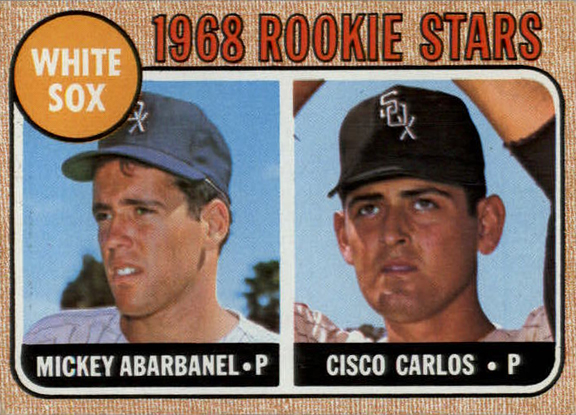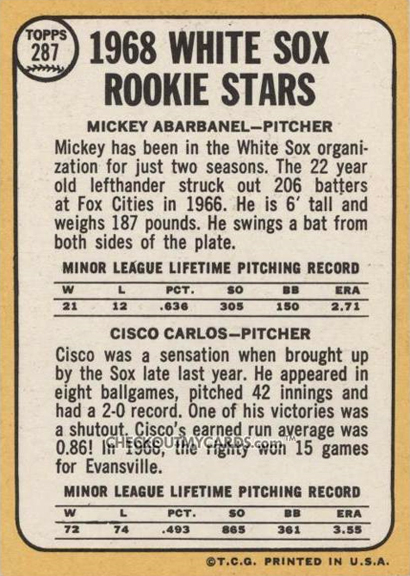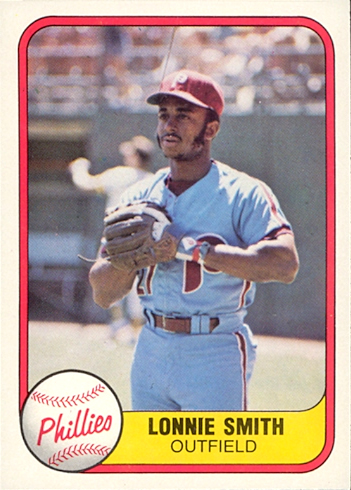Card of the Week: 1988 Score #638 Tom Glavine Rookie Prospect
20th February 2010
There is oh-so-much to like about this rookie baseball card of Tom Glavine:
- I have no idea if Glavine ever used banned substances but one thing I know for sure is the size and shape of his body didn't change throughout his career. Especially with his youthful face hidden in a shadow, the photo above could have been from almost any year of his career.
- The design of the 1988 Score set, and the Rookie Prospect subset, was just fantastic. Keep in mind that this was Score's debut set. From 1981 to 1987, there were just the three main baseball card producers--Topps, Fleer, and Donruss. In 1988 Score came on the scene with a simple yet great-looking set. Upper Deck would come along later to really change the card landscape, but in 1988 this set was big news.
- The photo itself is wonderful, especially since it includes an extra Braves logo visible in the background, the ball just coming out of Glavine's hand, and the entire field back to the outfield wall.
- Back in 1988, it was pretty uncommon to see photos on the back of cards, especially color photos. The backs of these cards were just great, with the color photo and multi-color text.
- The only thing I've never understood about this set is the purpose of the 3 stars on the front of card. (These stars appear on every card in the set.)
Let's talk a little bit about the player himself.
In the last 50 years of baseball, Glavine is one of just 10 players to amass at least 5 different 20-win seasons.
| Rk | Yrs | From | To | Age | ||
|---|---|---|---|---|---|---|
| 1 | Jim Palmer | 8 | 1970 | 1978 | 24-32 | |
| 2 | Fergie Jenkins | 7 | 1967 | 1974 | 24-31 | |
| 3 | Roger Clemens | 6 | 1986 | 2001 | 23-38 | |
| 4 | Steve Carlton | 6 | 1971 | 1982 | 26-37 | |
| 5 | Juan Marichal | 6 | 1963 | 1969 | 25-31 | |
| 6 | Tom Glavine | 5 | 1991 | 2000 | 25-34 | |
| 7 | Catfish Hunter | 5 | 1971 | 1975 | 25-29 | |
| 8 | Tom Seaver | 5 | 1969 | 1977 | 24-32 | |
| 9 | Gaylord Perry | 5 | 1966 | 1978 | 27-39 | |
| 10 | Bob Gibson | 5 | 1965 | 1970 | 29-34 | |
| 11 | Dave Stewart | 4 | 1987 | 1990 | 30-33 | |
| 12 | Wilbur Wood | 4 | 1971 | 1974 | 29-32 | |
| 13 | Mike Cuellar | 4 | 1969 | 1974 | 32-37 | |
| 14 | Luis Tiant | 4 | 1968 | 1976 | 27-35 | |
| 15 | Dave McNally | 4 | 1968 | 1971 | 25-28 |
I haven't looked at the numbers in detail, but my instinct is that winning 20 games is rarer these days than it used to be, thanks to 5-man rotations and fewer innings pitched by starters. Among active pitchers, nobody has more than two 20-win seasons. I wonder when we'll next see a guy win 20 games five different times. It might be a long time.
It's interesting to note, however, that Glavine's neutralized pitching numbers suggest that he didn't deserve a single 20-win season. His overall W-L record (neutralized) is 267-207 (.563) as opposed to his actual totals of 305-203 (.600.) Glavine's numbers were helped by playing on a lot of really good teams--still, though, we can't really hold that against him and the bottom line is that he pitched consistently and excellently for many years.
Glavine's post-season record mirrors that of the Braves over the same period--lots of appearances but mixed results. In 1995, the year the Braves won it all, Glavine pitched 28 innings and allowed just 5 earned runs. In 1997, however, he allowed 11 earned runs in 19.1 innings.
A reader Joseph made an interesting point about Glavine's numbers. He finished his first season (1987) and his last season (2008) with the same numbers: 2 wins, 4 losses, and a 5.54 ERA.
I want to touch a little more on this card, Glavine, and the Braves. In 1988, this card was not a good pull for a collector. Sure, it was a rookie prospect card, but it was a guy who had bad numbers in 1987 and a terrible season in 1988. In that latter season he had a lousy 80 ERA+ over 195 innings and led the league with 17 losses. The Braves were a lousy team and no kid wanted a rookie card of some lousy pitcher from a lousy team. But those who knew Glavine and baseball thought differently. In 1988, despite the bad overall numbers, there were some very good things. His WHIP was a reasonable 1.35, much better than would be expected for such a bad ERA. He allowed just a few more hits than IP and his walks per 9 IP was a very good 2.9. These were harbingers of things to come as Glavine went on to have very low walk totals in his career and also to allow fewer hits than innings pitched.
So in 1988, most card collectors (including me) took these Glavine cards and put them away in a box. In 1989 and 1990 Glavine was an average pitcher (which says something since the Braves were still bad) and then suddenly he exploded in 1991, right along with his team. He won 20 games and the Cy Young award and the Braves went to the World Series. That's when collectors went back to their boxes of commons to dig out the Tom Glavine rookie cards.
One more thing about Glavine's stats: he was a pretty good hitter. It is well known that the 1990s Braves starting pitchers fiercely competed over their hitting ability. Glavine, Greg Maddux, John Smolts, and Steve Avery all had some excellent batting seasons for the Braves. Glavine himself had 7 different seasons with at least 5 RBI and finished with 25 career doubles. Among active pitchers, only Livan Hernandez, Mike Hampton, and Carlos Zambrano can claim the same. Plenty of pitchers from days gone by did plenty better, but these days those are good numbers. It's just a shame he didn't have more numbers since chicks dig the long ball.
Let's hear your memories of this great pitcher, surely a HOFer one day.
Want to read a bit more on these topics? See the 1988 Score blog, which features info and many card photos from that set. You can also see my post on his Topps rookie card on my old 88 Topps blog.
Posted in Card of the Week | 11 Comments »





